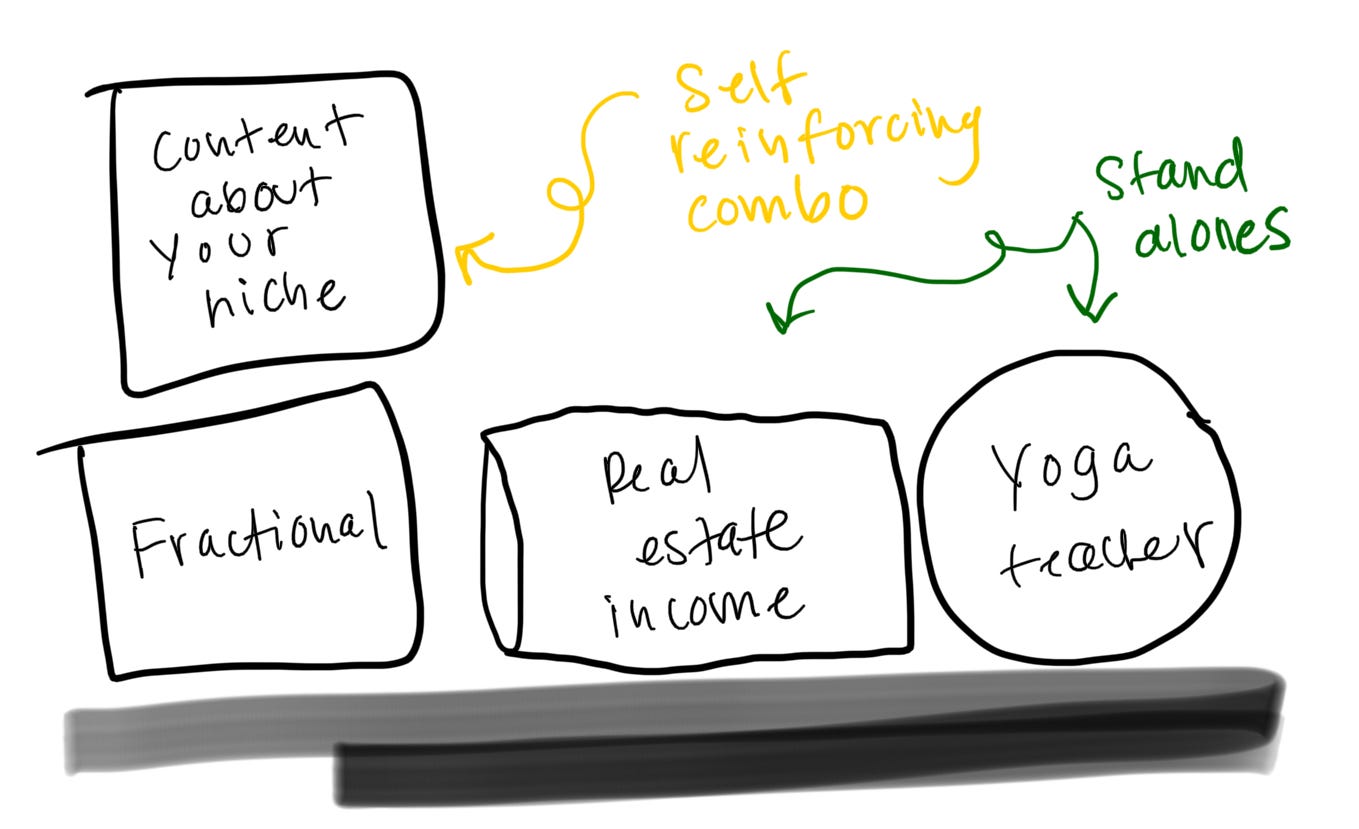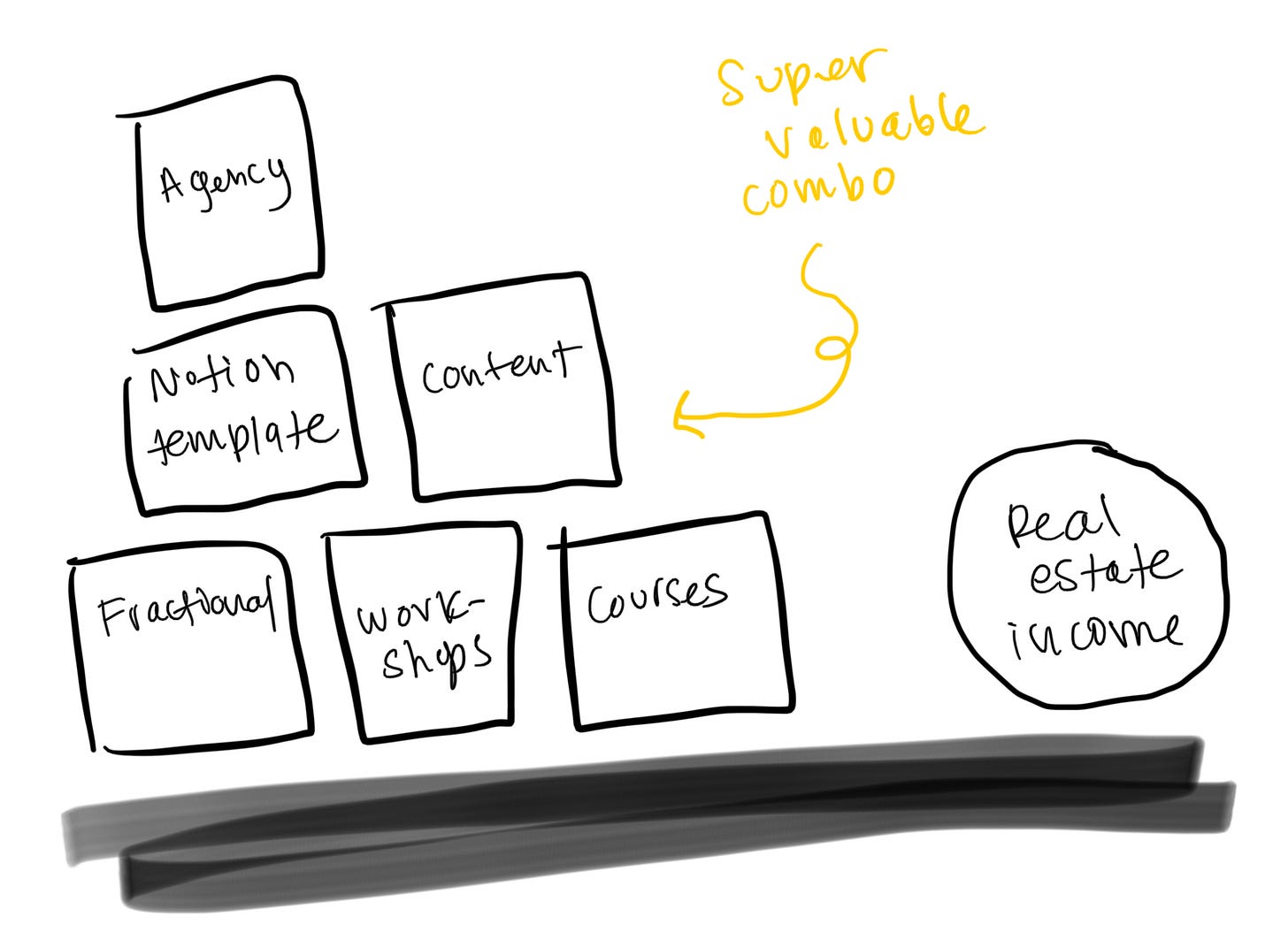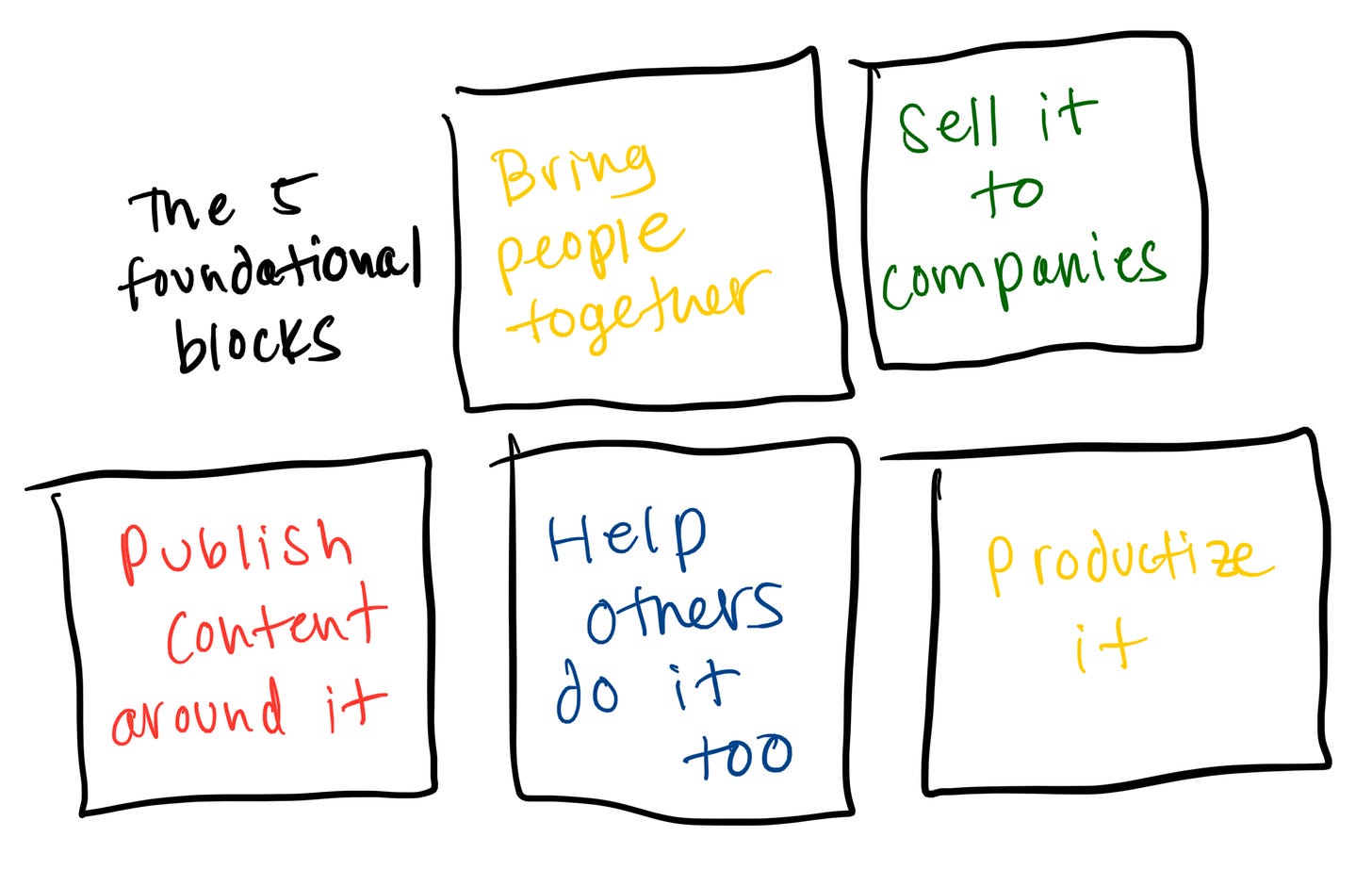Portfolio ideas for fractionals - part 1
Part 1 of 2 of my research behind how fractionals diversify their solo income
👋 Hey, it’s Shaina. I’m back for another issue of On Work, my weekly letter on solo entrepreneurship, fractional work, portfolio careers, and more.
A big ol’ welcome to the 23 of you who subscribed since last week — Hi! Welcome in! Help me spread the word by sharing with your friends, and please say hello in the comments.
Today, I’m sharing Part 1 in a series on the approaches that fractionals and consultants are using to diversify their income — how they’re layering income streams that let them make the most of their hard-won skills.
Read on for my theory on the 5 Foundational Blocks to use the wonderful, wild world of the internet to monetize your skills without selling your time to companies (plus, the doodles are back.)
In Part 2, we’ll cover ways the 5 Blocks combo together, and classic pathways for how the most successful Portfolio Careerists got started.
Before we get into it, 3 things to share I think you’ll be into:
Manual Override applications due on Friday: If you’ve been curious about Manual Override, our summer accelerator for independent businesses, the last day to apply is Friday, June 20! Lingering questions before you apply? Reply to this email, and I’ll help you out.
Free tax workshop on Wednesday: I’m hosting my friends at Collective for a free workshop on how to make the most of your independent business’ finances — Understand if an S Corp is right for you (it’s saved my own businesses major $$$), and learn how to retroactively save money on your 2024 taxes, even if you’ve already filed. Love that. Sign up here.
Pod to add to your weekday-walk listen queue: I joined my pals Melissa and Meredith on their Agency Darlings podcast last week to talk all things fractional hiring, startup team building, and where I think the future of work is heading amid a shaky economy and the rise of AI. Listen on Spotify.
Now onto today’s issue.
The smartest people in the room are stacking income streams
Back in 2022 before I quit my full-time job, I started noticing a curious thing: My very smartest friends were getting downright crafty with internet projects. At the time, I assumed they were at it to “build their personal brand,” or make some extra money, or learn new tools.
Regardless of their motivation, several years later, those same people are making many 10s to 100s of thousands of dollars a year from these seemingly simple projects.
They weren’t raising venture. They weren’t starting a tech company. They were taking the thing they knew the best - the skills they had proven expertise in - and using the internet to share those skills across new channels.
They were doing paid advising. And 1:1 Coaching. Starting tech-enabled services. Contract and fractional work. Layering with monetized podcasts, writing, and course creation. Selling simple templates and tools they built without writing code. And they were posting about it constantly, building an audience of customers and fans along the way. Emily, Lenny, Elena, Milly, Mallory. I could go on and on with examples.
These smart people were starting portfolio companies — independent businesses with several income streams — based on their skills.
Today, now that capital F Fractional work is a bonafide movement, the same curious thing is happening among fractionals, particularly those with a startup background.
Fractional work is becoming the gateway to broader entrepreneurship.
Fractional work is awesome in that it’s self-employment you can get started on pretty easily. You don’t need any up front capital. You really don’t need much beyond your expertise and a few intros.
And that gateway moment to entrepreneurship? It shows up real fast: all of a sudden, you work for yourself. And when you work for yourself, you can do whatever you want.
For some, that means that fractional work alone scratches their itch, and lets them meet their personal goals. But the set of people I’m most interested in see that they can take their core expertise and sell it across many channels, not just through contract employment.
They see tons of opportunity.
They view fractional work as one building block in their stack of income streams.
This is my story. I quit the best paying job I ever had to chase after contract work: I got started as a Fractional COO and Chief of Staff for early stage startups, and that work gave me confidence that I could support myself without a W2. It was the foundation for me. It was the gateway. And it gave me the itch to think bigger.
Today, I’ve built 4 channels on that foundational expertise:
Hello Generalist is a tech-enabled service business, and I’m still the sole full-time employee. Over the years, I’ve grown the team with fractional hires, and their impact can’t be overstated, but it’s still just little ol me building the business day in and out.
Manual Override is the newest business that follows this same line of thinking. While Harry’s come in as a 50/50 partner, our shared goal is to build this profitably with a small team. (Harry’s also on the fractional-to-entrepreneur journey in his own right.)
I still take on contract work with startups, though these days, it’s mostly advising, and less embedded fractional, purely due to time constraints. I love this work, but am focused on income that doesn’t exchange my time for money.
I work as a coach to startup operations leaders, helping individuals grow in their leadership and human journeys inside early stage startups. Like the contract work above, this is a direct exchange of my time for money, but it’s heartfelt, meaningful work that I love doing.
My point being - it all started with fractional.
I’m obsessed with this type of work, and fascinated by the people who are walking the path. For me, a portfolio approach is less risky than relying on one channel, keeps me learning and my days super interesting, and as I build more channels, each new product enables all the rest.
Let’s break it down.
Building blocks and combos
I like to think about this movement with the metaphor of old school wooden blocks. Think: sweet, wooden, children’s blocks.
You’ve got blocks, and you’ve got combos of blocks.
All blocks are a worthy part of the set, but some blocks stack naturally on top of each other, creating little castles and houses. Other blocks don’t easily stack, and topple over when you try to combo them.
You likely get where I’m going with this:
Each income stream is a block. Some income streams stand alone, without mutually reinforcing others, and without telling a wholistic story. Those portfolios look like products and services that don’t share the same customer, or don’t solve the same problem. All the blocks are still useful income streams for your life, but they’re hard to build on.
Instead, the more advantageous approach is to build combos: income streams that reinforce each other by solving a variety of problems for similar customers, or ones that are joined by a common world view.
Here’s more of what I mean.
The 5 Foundational Building Blocks: The most common skill-based businesses
You don’t just get a combo of interrelated income streams overnight. You have to start somewhere. Among tech folks who aspire to work for themselves, I’ve noticed 5 common paths they take to monetize their skills:
1. Sell your expertise to companies as a service
What this is: Fractional work, consulting, special projects, pre-set workshops, and other ways to directly help a company achieve their goals.
The business model: Retainer, hourly fee, or value-based price for the work you do. Sometimes, you also take equity or receive a cash bonus. Typically, the money you earn is related to the time you spend with them.
Pros: Fairly easy to get started (Get intros from people you know! I wrote all about this here). It’s like doing the thing you were full-time, but now you’re working for yourself. And, if you’re like me, this is also a massive confidence builder that you can layer other income streams on top.
Cons: You’re trading time for money pretty directly. Difficult to scale this beyond the amount of hours you’re willing to work.
Examples:
You know these people! You’re likely this person :)
2. Productize your service
What this is: Turn your skills into products that you sell online without delivering the service in real time. Simple routes look like pre-recorded workshops, self-serve courses, Notion templates, or simple SaaS tools. A more sophisticated route is to build a tech-enabled services business or agency.
The business model:
Pay to purchase your thing: Someone enters their credit card, and bam, they get the thing online.
Get paid when others offer the service: If you can turn your skill into a tech-enabled service business or agency, other individuals do the service instead of you, and you make money as the connector.
Pros: Massively scalable.
Cons: Helps to have an online audience to drive scaled distribution, but you’d be surprised how many of your immediate contacts would be your first customers.
Examples:
Notion template: Anna Mackenzie’s Portfolio Career OS
Tech-enabled services (that all started with, or continue to be run by a solo founder): Hello Generalist, storyarb, Verbatim, Sundays
3. Teach your expertise to individuals
What this is: Take what you know, and help others do it too through coaching, courses, workshops, mentorship, and more.
The business model: 1:1s, small groups, and large cohorts, selling for hourly rates, single prices for the whole package, or an overall program fee.
Pros: Like fractional work, some of these models are fairly easy to get started. Get the word out there in online communities and your network.
Cons: Helps to have an online audience to drive scaled distribution, but you’d be surprised how many of your immediate contacts would be your first customers. Like fractional work, you’re still selling your time for money, but the scaled, group cohort courses can be much more efficient. (We regularly hear about popular course creators on Maven booking several hundred thousand through one course cohort.)
Examples:
Our own Manual Override is a twist on the live online course model
Self-serve course: Greg Isenberg’s Startup Empire
Guided courses and workshops: Brie’s personal branding workshops, Happy Paying Customers, Emily’s new course on Maven
4. Bring together people
What this is: Communities, digital workshops, and IRL meet-ups that bring together like-minded people, or people with a common goal
The business model: Charge individuals to join or attend, or lock in corporate sponsors once the group gets large enough
Pros: Brings network effects into your business: the value of the group increases as more people join. You’re no longer just selling you — you’re selling access, relationships, and a sense of belonging. Can be a powerful long-term asset.
Cons: Very hard to get right. People are flaky. Engagement is hard. Running a community is a service business in disguise, and many people underestimate the time and emotional labor it takes to moderate, nurture, and maintain quality over time.
Examples:
5. Publish what you know online
What this is: Sell advertisements or charge for subscriptions: This looks like paid subscribers on Substack, Podcast sponsorships, YouTube ads, and more.
The business model:
Ad-supported: YouTube ads, podcast sponsorships
Subscriber-supported: Paid newsletters (Substack), member-only content
Hybrid: Free top-of-funnel content that drives to products, courses, or services
Pros: Builds your reputation and visibility. Over time, content becomes an asset that generates leads, interest, and brand equity, and can generate income for you while you sleep.
Cons: It takes time to build trust (you’re playing the long game). The internet rewards consistency, so this can feel exhausting. More, income can be variable and delayed (especially for newer creators).
Examples:
Paid Substacks that drive to other income streams: Lenny’s Newsletter, Packy McCormick (Not Boring)
Other monetized content that drives revenue elsewhere: Ali Abdaal (YouTube + courses + book + community), Steph Smith (blog + podcast + book + course)
In Part 2, we’ll cover the most impactful Combos of these 5 Blocks, plus the pathways popular Portfolio Careerists used to get started. Want to contribute? Share your Blocks, Combos, and how you got started in the comments, and I’ll feature you in Part 2✌️
Before we head out, if you’re into the ideas I write about, here’s a few ways for us to work together:
Want 1:1 time with me to talk about building your independent business? I’ll show up judgement free and candid, and make this hour a super valuable one for you. You can read more and book that here.
Are you a startup who’s curious about fractional hiring? Check out Hello Generalist, or book a call with me here.
Are you an independent business owner who wants to grow your pipeline? Considering applying to Hello Generalist’s network, or checking out Manual Override, our business accelerator.
And check out the On Work Podcast to hear stories from the tech operators, entrepreneurs, and experts behind this independent work movement — you can subscribe on Spotify and YouTube.
Be well! Until next week, Shaina









Eager for part 2 👀🙏🏽🍿
Really appreciate this breakdown, especially the cons to each which people tend to gloss over.